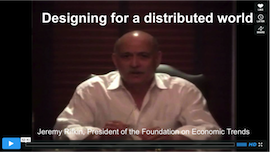How does new technology such as peer-to-peer sharing, traceability, and enterprise software create a flexible, resilient and sustainable food system?
By connecting buyers and sellers; streamlining production, procurement and distribution; creating networks of buying groups; and linking producers in a series of hubs, today’s technology – including wireless networks and mobile and open-source desktop applications – will catalyze change in the interconnected web of local and regional food systems.
For example, a local fruit and vegetable producer could share product availability and pricing instantaneously with consumers and create optimized delivery schedules. The same communication technology would allow the farmer to provide information to a processor and create a just-in-time product sourcing system. Or, using enterprise software designed for SMBs (small and medium-sized businesses), he or she could forecast and contract sales, and schedule planting, harvesting, and production activities efficiently and profitably.
Following is a recording of Jeremy Rifkin, President of the Foundation on Economic Trends, as he discusses the shift from point source to distributed thinking and implications for our food systems.
(Sorry for the poor quality, this is a video recording of a video presentation.)
Read an excellent summary of the National Sustainable Food Summit at which this presentation was given by Sam Rye here on Food+Tech Connect.

